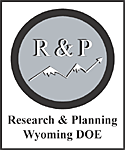Research & Planning Downloads Top
Quarter Million in 2008
The Wyoming Department of Employment, Research & Planning (R&P) publishes wide-ranging information and analysis on Wyoming’s labor market. Labor market information produced by R&P varies from the routine, such as monthly unemployment rates, to the customized, such as commuting patterns between Laramie County, Wyoming and the Colorado Front Range. Analysis of customer contacts, mailings, and visits to R&P’s website show that more than 225,000 publications were downloaded in 2008, and R&P contacts with media averaged more than 10 interviews per month. Analysis of these interactions allows R&P to determine the most efficient means of disseminating information and provides clues about ways in which R&P customers use that information.
As a state statistical entity, R&P “is a unit of the state government whose principal function is the compilation and analysis of data and the dissemination of information for statistical purposes” (Gallagher, 2007). In addition to serving the needs of labor market stakeholders, the information produced by R&P is a means to hold government accountable. As a statistical entity, R&P has no stake in decisions made by others who use the data and analysis produced. This allows analysts to conduct quality, unbiased research.
Ideally, information producers such as R&P could quantify the value of information produced. Doing so would help information producers understand what consumers find useful and allow them to reallocate resources (financial, human, etc.) towards producing new or improved information products. Instead, information producers rely on indirect measures such as the number of publications distributed or how many files were downloaded during a period.
Increasingly, information products are distributed electronically.
Table 1 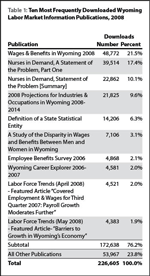 shows 10 publications from R&P’s main website that, combined, were
downloaded more than 172,000 times.
shows 10 publications from R&P’s main website that, combined, were
downloaded more than 172,000 times.
Producing information is an iterative process between R&P and the federal, state, and local institutions that fund research and analysis, U.S. Department of Labor national and regional office staff, information consumers, and others. R&P strives to provide objective, accurate, and useful information within various constraints including confidentiality laws, funding, and human resources. The feedback received from various sources helps R&P meet that goal.
R&P has limited knowledge about how and why consumers use its products, but several aspects of R&P’s readership can be quantified:
- Internet sites most frequently visited
- Numbers of hard copy and electronic publications and products distributed
- The number of files downloaded from R&P’s website
- The satisfaction level of a selected number of Wyoming Labor Force Trends subscribers
R&P does not know precisely who uses its products; why they are used is even broader in scope. Nor does R&P know the time between when the information was acquired and when a decision using the information is actually made. Secondly, news media act as both consumers and intermediate producers of information. R&P cannot quantify how many people read articles using R&P data, nor how many times a particular article from a single newspaper is read. Lastly, even if it is known that a particular information product has a high frequency of downloads, details about the population using it remain elusive. Anecdotally, R&P knows information customers such as nurses are keenly interested in the labor market dynamics of their profession, and are more than willing to network with others in their profession to distribute and assimilate information. In 2008, nearly 60,000 files of the R&P reports on nurses were downloaded, but there were only 3,808 active nurses in Wyoming as of first quarter 2008 (Leonard, 2008). This suggests a broader range of customers exists for this information than just nurses in Wyoming.
Some information produced by R&P is authorized and/or required by federal law. Data collection and analysis for these and other programs are overseen by two agencies within the U.S. Department of Labor: the Bureau of Labor Statistics (BLS) and the Employment & Training Administration (ETA). BLS primarily funds the production of standard outputs. Production of BLS outputs is coordinated with and overseen primarily by regional office staff. In contrast, ETA provides state agencies wider latitude in how agreed-upon objectives are met.
R&P conducts other research by agreement with and funded by other institutions, public and private. Research conducted on behalf of other institutions is conducted with the understanding that R&P will retain objectivity and control over its production. R&P strives to make the process as transparent as possible to funding entities without relinquishing objectivity or control of the outputs. Some of the most popular reports (based on counts of reports downloaded) were funded by the Wyoming Healthcare Commission involving health care labor market research (see Table 1 for downloads; the reports are available at http://doe.state.wy.us/LMI/nursing.htm). Past research has also been funded by institutions such as the Wyoming Community College Commission (see http://doe.state.wy.us/LMI/education.htm). While these information products were funded by specific institutions, the products serve other interests as well. The nursing studies, for example, provide policy makers with insight into the labor market for nurses, past and present, as well as various scenarios for what future nursing demand may look like.
Establishing Value by What is Known
To gain a better understanding of what customers value, R&P compiled statistics pertaining to the distribution of hard copy and electronic publications and products. Data sources include results from a survey of Trends subscribers, monthly staff reports of hard and electronic copies of publications and products distributed, WebTrends (software used to compile statistics about activity on a website), and monthly staff-reported interactions with the media. These statistics are discussed in the following sections.
Accessing Wyoming Labor Market Information from the Internet
The Wyoming Labor Market Information website (http://doe.state.wy.us/LMI/) is R&P’s primary Internet portal. The site provides a gateway to all R&P publications and statistics released in hard copy and electronic formats. Some information and documentation produced by R&P is published exclusively on the Internet for two reasons. First, electronic publication is less expensive than producing printed publications. Second, it permits lengthy tables and methodology to be available to interested users without lengthening a publication for those whom the additional detail is unnecessary.
Users’ activity on the LMI website is defined in two ways, visits and downloads:
- Visit – a series of actions that begins when a visitor views the first page from the server and ends when the visitor leaves the site or remains idle beyond the idle-time limit (30 minutes). In 2008, a total of 187,174 visits to the LMI delivery system pages were recorded.
- Download – when actions are taken by an individual to transfer a file from the LMI website to another electronic location.
While counting visits to a website may signal interest, tracking those files that are downloaded provides a more accurate indication of consumers’ interests. For example, a visitor may access a site but not find anything of interest or the type of information he or she is seeking. However, when a visitor takes specific actions to download a file, this demonstrates interest in specific data and/or analysis.
During 2008, customers downloaded 226,605 files
from the Labor Market Information site (see Table
1). The most frequently
accessed pages were those pertaining to nurses, particularly those related
to retirement, recruitment, and retention. In 2007 the Wyoming Healthcare
Commission employed R&P’s
expertise in labor market research to study nursing profession labor market
issues. Two of the Nurses in Demand publications accounted for more than
one-fourth of all downloaded files (27.5%; 62,376 total downloads). As
primary care givers, nurses are projected to be in high demand as the overall
age of the population rises in coming years (Cowan, Jones, Knapp, Leonard, & Saulcy,
2008). Understanding labor market dynamics helps stakeholders create informed
policies and actions.
Interest was also demonstrated in employee compensation-related publications
(wages and benefits). Users downloaded 48,772 copies (21.5%) of Wages & Benefits
in Wyoming 2008, the most of any individual publication. Employee
Benefits 2006 was retrieved 4,868 times (2.1%). These reports were accessed a combined
total of 53,640 times (23.6% of total downloads).
Table 2 shows in descending order the number of Wyoming County Fact 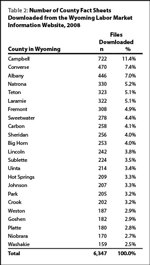 Sheets
downloaded in 2008. A total of 6,347 fact sheets were retrieved (2.8% of
the total). Campbell County’s fact sheet was the most frequently downloaded
(722; 11.4% of fact sheets downloaded), with 200 more fact sheets retrieved
than the next most frequently downloaded county fact sheet for Converse
County (470; 7.4% of fact sheets downloaded). Interest in Campbell County
could be related to employment growth that occurred there in 2008. These
county fact sheets are being revised and will be posted on the website
when that process is complete.
Sheets
downloaded in 2008. A total of 6,347 fact sheets were retrieved (2.8% of
the total). Campbell County’s fact sheet was the most frequently downloaded
(722; 11.4% of fact sheets downloaded), with 200 more fact sheets retrieved
than the next most frequently downloaded county fact sheet for Converse
County (470; 7.4% of fact sheets downloaded). Interest in Campbell County
could be related to employment growth that occurred there in 2008. These
county fact sheets are being revised and will be posted on the website
when that process is complete.
Wyoming Labor Force Trends is R&P’s monthly magazine. The publication
contains monthly statistics on Wyoming nonagricultural wage and salary
employment, economic indicators, county unemployment, and unemployment
insurance statistics. Some statistics such as unemployment-insurance covered
employment and wages and turnover statistics are published quarterly. In
addition to routinely published statistics, Trends includes a feature article
that provides additional information on a labor market topic. In 2008,
R&P surveyed Trends subscribers to get a sense of users’ satisfaction
levels. Of 284 respondents, 88.7% indicated they were satisfied or very
satisfied with the publication (see Table 3). 
Table 4 shows the number
of times the feature article for a given month in 2008 was downloaded within
three months of publication. “Cashing  Out?
Labor Market Withdrawal by Wyoming Workers Age 45 and Older” from the June
issue was most frequently downloaded (2,630; 17.7% of feature articles
downloaded). Interest in this topic is further demonstrated by the fact
that the research was highlighted in at least two separate Wyoming newspapers
in 2008, the Casper Star-Tribune and the Wyoming
Business Report (see the articles online at http://tinyurl.com/n9m9wx and http://tinyurl.com/mr67hg).
Out?
Labor Market Withdrawal by Wyoming Workers Age 45 and Older” from the June
issue was most frequently downloaded (2,630; 17.7% of feature articles
downloaded). Interest in this topic is further demonstrated by the fact
that the research was highlighted in at least two separate Wyoming newspapers
in 2008, the Casper Star-Tribune and the Wyoming
Business Report (see the articles online at http://tinyurl.com/n9m9wx and http://tinyurl.com/mr67hg).
Research & Planning Information Products and Media Use
News media act as both consumers and distributors
of information. As information providers themselves, they find, filter,
condense, and communicate what they think consumers will find interesting
or useful. The challenge is to know who consumes R&P information from news media sources. Approximate
hard copy circulation counts are available for newspapers that use R&P
information. R&P also knows about media interactions (usually interviews)
with staff from monthly reports. Circulation of newspapers and magazines
varies from a few hundred to millions of subscribers (see Tables
5a and
5b). Publications in
which R&P
data have been cited are as diverse as small (in terms of circulation)
statewide
in
which R&P
data have been cited are as diverse as small (in terms of circulation)
statewide  newspapers like the Daily
Times (Rawlins) to nationally-distributed
publications such as Forbes and Redbook.
newspapers like the Daily
Times (Rawlins) to nationally-distributed
publications such as Forbes and Redbook.
In 2008, R&P distributed hard copies and electronic versions of 2,340 press releases covering various Wyoming labor market topics. R&P staff were interviewed on 79 separate occasions by various media outlets. The media interviews suggest that public information entities rely on R&P to report on routine labor market information (e.g., monthly unemployment rates, job growth) as well as less frequently published data and statistics on topics such as workplace fatalities.
In addition to the information provided to visitors
to R&P websites,
R&P data appeared in a variety of media outlets in both online and
hard copy formats. R&P information was used by media an average of
12.8 times per month (see Table 6). Slightly more than 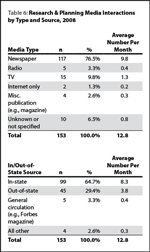 three-fourths
of coverage was from newspapers (online or hard copy) for an average of
9.8 appearances per month. Nearly two-thirds of media coverage was from
in-state sources such as the Casper Star-Tribune and Wyoming Public Radio.
R&P data appeared an average of 8.3 times per month in these sources.
Current Employment Statistics (CES) and Local Area Unemployment Statistics
(LAUS) as released by R&P in the standard monthly news release were
the most frequent topics, accounting for 45.1% or an average of 5.8 times
per month (see Table 7). LAUS and CES
three-fourths
of coverage was from newspapers (online or hard copy) for an average of
9.8 appearances per month. Nearly two-thirds of media coverage was from
in-state sources such as the Casper Star-Tribune and Wyoming Public Radio.
R&P data appeared an average of 8.3 times per month in these sources.
Current Employment Statistics (CES) and Local Area Unemployment Statistics
(LAUS) as released by R&P in the standard monthly news release were
the most frequent topics, accounting for 45.1% or an average of 5.8 times
per month (see Table 7). LAUS and CES 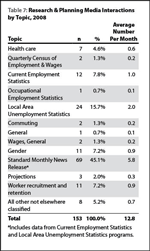 data, separate from the
monthly news release, were cited the next most often at 15.7% and 7.8%,
respectively. In addition to routine statistics, other topics garnering
media attention included gender and worker recruitment and retention. Both
were used by the media 11 times each, an average of 0.9 times per month.
The fact that R&P data appear with some degree of regularity may suggest
that media find the information accurate, useful, reliable, and of interest
to their readers. Additionally, their costs for searching for information
produced by R&P are low because they know that the information will
be available in a timely manner (e.g., monthly news releases) and they
know where to locate it.
data, separate from the
monthly news release, were cited the next most often at 15.7% and 7.8%,
respectively. In addition to routine statistics, other topics garnering
media attention included gender and worker recruitment and retention. Both
were used by the media 11 times each, an average of 0.9 times per month.
The fact that R&P data appear with some degree of regularity may suggest
that media find the information accurate, useful, reliable, and of interest
to their readers. Additionally, their costs for searching for information
produced by R&P are low because they know that the information will
be available in a timely manner (e.g., monthly news releases) and they
know where to locate it.
Summary
R&P products serve a variety of purposes for labor market stakeholders. Because of R&P’s position as a state statistical entity, customers rely on its information to be objective and accurate. While it is generally understood that information has value, quantifying the value is a complex undertaking. A handful of resources such as counts and types of electronic and hard copy publications and products distributed permit indirect value measurement as to what information products consumers find worthwhile. By working with the information available, R&P can serve its customers more effectively.
References
Cowan, C., Jones, S., Knapp, L., Leonard, D., & Saulcy, S. (2008, March). Nurses in Demand: A Statement of the Problem. Retrieved July 1, 2009, from http://doe.state.wy.us/LMI/nursing_demand_08.pdf
Farquhar, B. (2008, August). “High housing values allow boomers to cash in, out.” Wyoming Business Report. Retrieved July 1, 2009, from http://tinyurl.com/mr67hg
Gallagher, T. (2007). Definition of a State Statistical Entity. Retrieved August 20, 2009, from http://doe.state.wy.us/LMI/statistical_entity.pdf
Leonard, D. (2008, August 7). The NEW Report: Nurse Employment in Wyoming (NEW). Retrieved August 20, 2009, from http://doe.state.wy.us/LMI/dashboard/toc.htm
Mast, T. (2008, July 6). Git while the gittin’s good? Casper Star-Tribune. Retrieved July 1, 2009, from http://tinyurl.com/n9m9wx
U.S. Department of Labor, Bureau of Labor Statistics. (n.d.). Subject Areas. Retrieved June 26, 2009, from http://www.bls.gov/bls/proghome.htm
